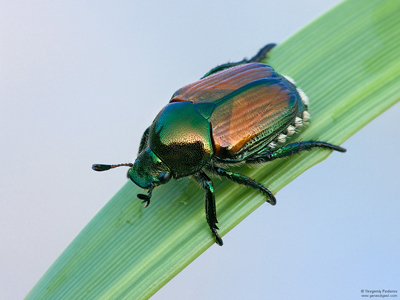Like a Southern drawl popping up on the West Coast, our accents mark us as newcomers. With time they fade, leaving only traces of our past in the occasional slip of a word.
Northern Arizona University researchers led by Bruce Hungate, director of the Center for Ecosystem Science and Society, have found the microscopic equivalent of an accent in an invasive pest: the Japanese beetle. This microscopic “accent” is the amount of a rare but stable hydrogen isotope in the beetles’ body tissues. The results, published in PLOS ONE, can help invasive pest managers answer the question of whether a beetle detected in new territory is new or part of an established population in the area.
“Knowing the timing of arrival of these invasive organisms can be really helpful in managing them, and the stable isotope gives us a very useful chemical clock,” Hungate said. “It’s a powerful addition to the tools we have to understand where these organisms are from and the dynamics of their movements.”
Japanese beetles wreak havoc by feeding on over 300 plants, contributing to the billions of dollars per year in economic costs caused by invasive species. Japanese beetles are well established in the eastern United States. Control efforts at airports on both coasts aim to keep the beetles from spreading westward, with only partial success.
Researchers studied colonizing beetles trapped at Portland International Airport in Oregon over the past decade to develop this new technique.
The study used isotopes as a sleuthing tool. Hydrogen, like other elements in nature, occurs in slightly different forms, called isotopes. One of the heavier isotopes of hydrogen, deuterium, is rare but stable, meaning it does not decay. The amount of this isotope—its signature—in local water sources varies from place to place, and has been found to match the signature in tissues of plants and animals consuming the local water.
Researchers found a close relationship between the stable hydrogen isotope signature in beetle tissue and local water from 71 sites around the country. Combined with the signatures of water at known sources of Japanese beetles in the East, these results provide a sort of “geographic fingerprint” to determine where the beetle is from.
To model the time since arrival, researchers transplanted Eastern beetles to a Western environment and measured the signature change over time. The hydrogen isotope signature in beetles began to change after two weeks and took about five weeks to equilibrate to the new environment. This offered a new clue: beetles trapped at points of entry to an area, like airports, are likely to be new arrivals if their signature is distinctly different from the signature of water in the local area.
The transplant experiment also asked a more refined question about beetle origins: Would the signature from the hard, chitin-rich tissue of the beetle’s wing covers change more slowly, preserving clues about the beetle’s origin longer, like the trace of accent we retain after we are no longer newcomers? They found that signatures did shift more slowly in hard tissue, adding it as a potential tool for tracing the origin of beetles.
The resulting model pointed to the southeastern United States as the origin of beetles trapped at the Portland International Airport. And beetles trapped after 2011 appeared to have been more recent arrivals than beetles trapped in earlier years, suggesting that efforts to prevent beetles from establishing viable populations at the Portland International Airport seemed to be working.



